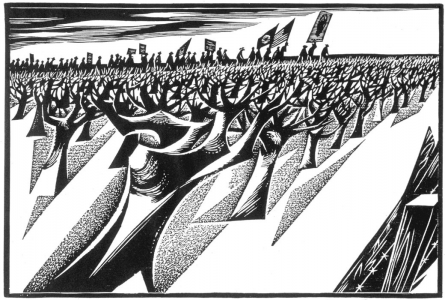
Biography
Richard Correll's father was a lawyer, school teacher and master carpenter; his mother had trained in music at Oberlin. He was interested in art from an early age but had no formal training. When his family moved to Los Angeles in the 1920s, after a number of years on small farms in Oregon and California, Correll joined his father, brother and uncle in home construction. With the onset of the Depression and the collapse of the housing boom, Correll opened a shop to do sign painting and calligraphy, taking a few art courses at the Chouinard Art Institute.The 1930s were a time for growth on Correll's part - both in terms of his political awareness in the face of the dramatic poverty of that era, and in terms of his own artistic development. The two issues were closely linked for him. He saw art as a means of political expression; and he was thrown into contact with a host of talented artists when he moved to Seattle and joined the Federal Art Project. His FAP tenure marked his real artistic education. His style matured, and he focused primarily on wood cut and linoleum block prints, while also doing some etchings and lithographs. This work received national recognition. One series of prints - and a mural that he completed for the Arlington, Washington High School focused on folkloric themes, specifically the legend of Paul Bunyan. Meanwhile Correll was active in forming the Washington Artists' Union.
With the onset of World War II, Correll moved to New York, where he found employment as a commercial artist. He served as an Air Raid Warden for Greenwich Village and joined the progressive Artists League of America, which brought him into contact with influential East Coast artists of that era. He moved back to California in 1952, settling in San Francisco and continuing to do commercial art. He joined the Graphic Arts Workshop, which brought him into the thick of the San Francisco art scene. Although his temperament never meshed well with the world of commercial art, Correll continued that line of work until his retirement in 1969. More to his liking was the printmaking that he continued throughout his lifetime, with particular attention to political causes.


Critical Analysis
Correll was never one to follow trends. He said that what he really liked was the act of making art. This attitude produced a very dramatic style, that resulted in striking black and white prints whose power holds up to this day. You can find his work in the collections of many major museums, and through that work you can sense Correll's strong social conscience and uncompromising focus upon his ideals. It's no surprise to learn that he marched with Caesar Chavez; his prints of that march make the viewer feel present at that march even now.Murals
- Arlington, Washington - Former Arlington High School: Bunyan at Stillaguamish
- Arlington, Washington - Former Arlington High School: Dairy Scene
References
- About Richard V. Correll and His Work (Richard V. Correll).
- Biographies of Northwest Realist Painters (Cascadia Art Museum Volunteers).
- Leslie Correll, A Daughter Remembers: The Work and Lessons of Muralist Richard Correll, Living New Deal October 30 (2015).
- Images of Labor and Social Justice: The Art of Richard V. Correll (University of Washington Libraries, Digital Collections).
- Learn Yourself: Richard Correll, Woodcut and Print Artist (Public Radio Exchange (PRX)). Special segment of the program "We Do The Work" hosted by Mike Dumovich. Audio runs for 28:19.
- Jen Graves, The Protest Artist, The Stranger February 6 (2013).
- Richard V. Correll (Wikipedia).
- Richard V. Correll (Annex Galleries).
- Richard V. Correll prints and papers, circa 1927-2012 (Archives West).